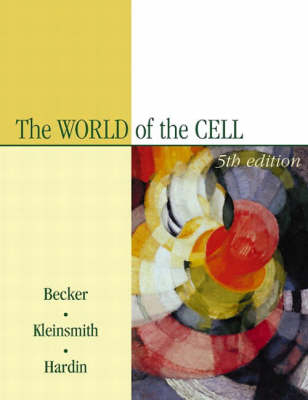
The World of the Cell with Free Solutions
Benjamin-Cummings Publishing Company, Subs of Addison Wesley Longman, Inc (Verlag)
978-0-8053-4547-6 (ISBN)
- Titel erscheint in neuer Auflage
- Artikel merken
The World of the Cell, Fifth Edition combines the most readable book and effective learning package available for introductory cell biology. The book gives readers the basics of cell structure, function, and mechanisms. This book continues the tradition of the previous editions widely praised for covering some of the most difficult concepts, including bioenergetics, metabolism, enzyme kinetics, thermodynamics, membrane transport, cell signaling, regulatory mechanisms, transcription, signal transduction, and DNA replication and recombination.
Wayne M. Becker teaches cell biology at the University of Wisconsin, Madison. His interest in textbook writing grew out of notes, outlines, and problem sets that he assembled for his students, culminating in Energy and the Living Cell, a paperback text on bioenergetics published in 1977, and The World of the Cell, the first edition of which appeared in 1986. He earned all his degrees at the University of Wisconsin, Madison. All three degrees are in biochemistry, an orientation that is readily discernible in his textbooks. His research interests have been in plant molecular biology, focused specifically on the regulation of the expression of genes that encode enzymes of the photorespiratory pathway. His interests in teaching, learning, and research have taken him on sabbatical leaves at Harvard University, Edinburgh University, the University of Indonesia, the University of Puerto Rico, Canterbury University in Christchurch, New Zealand, and the Chinese University of Hong Kong. His honors include a Guggenheim Fellowship, a Chancellor's Award for Distinguished Teaching, and a Visiting Scholar Award from the Royal Society of London. Lewis J. Kleinsmith is a Professor of Molecular, Cellular, and Developmental biology at the University of Michigan, where he has served on the faculty since receiving his Ph.D. from Rockefeller University in 1968. His teaching experiences have involved courses in introductory biology, cell biology, and cancer biology, and his research interests have included studies of growth control in cancer cells, the role of protein phosphorylation in eukaryotic gene regulation, and the control of gene expression during development. Among his numerous publications, he is the author of Principles of Cell and Molecular Biology, first published in 1988, and several award-winning educational software programs. His honors include a Guggenheim Fellowship, the Henry Russell Award, a Michigan Distinguished Service Award, citations for outstanding teaching from the Michigan Students Association, a Thurnau Professorship, an NIH Plain Language Award, and a Best Curriculum Innovation Award from the EDUCOM Higher Education Software Awards Competition. Jeff Hardin received his Ph.D. in biophysics from the University of California, Berkeley, and pursued post-doctoral work at Duke University. In 1991 he joined the faculty of the Zoology Department at the University of Wisconsin, Madison, where he is currently an associate professor. His research interests center on how the cells move and change the shape of the embryo..Dr. Hardin's teaching is enhanced by his extensive use of video-microscopy and his Web-based teaching materials, which are used on many campuses in the United States and other countries. As part of his interest in teaching biology, Dr. Hardin has been involved in several teaching initiatives, including being a founding member of the University of Wisconsin system-wide instructional technology initiative known as BioWeb. He is currently faculty director of the Biocore Curriculum, a four-semester honors biology sequence for undergraduates. His teaching awards include a Lily Teaching Fellowship and a National Science Foundation Young Investigator Award.
I. THE WORLD OF THE CELL: AN OVERVIEW OF STRUCTURE AND FUNCTION.
1. A Preview of the Cell.
2. The Chemistry of the Cell.
3. The Macromolecules of the Cell.
4. Cells and Organelles.
5. Bioenergetics: The Flow of Energy in the Cell.
6. Enzymes: The Catalysts of Life.
II. MEMBRANES AND CELL SIGNALING.
7. Membranes: Their Structure, Function and Chemistry.
8. Transport Across Membranes: Overcoming the Permeability Barrier.
9. Signal Transduction Mechanisms: I. Electrical Signals in Nerve Cells.
10. Signal Transduction Mechanisms: II. Messengers and Receptors.
11. Beyond the Cell: Extracellular Structures, Cell Adhesion and Cell Junctions.
12. Intracellular Compartments: The Endoplasmic Reticulum, Golgi Complex, Endosomes, Lysosomes, and Peroxisomes.
III. ENERGY FLOW IN CELLS.
13. Chemotrophic Energy Metabolism: Glycolysis and Fermentation.
14. Chemotrophic Energy Metabolism: Aerobic Respiration.
15. Phototropic Energy Metabolism: Photosynthesis.
IV. INFORMATION FLOW IN CELLS.
16. The Structural Basis of Cellular Information: DNA, Chromosomes, and the Nucleus.
17. The Cell Cycle: DNA Replication, Mitosis, and Cancer.
18. Sexual Reproduction, Meiosis, and Genetic Recombination.
19. Gene Expression: I. The Genetic Code and Transcription.
20. Gene Expression: II. Protein Synthesis and Sorting.
21. The Regulation of Gene Expression.
V. THE CYTOSKELETON AND CELL MOTILITY.
22. Cytoskeletal Systems.
23. Cellular Movement: Motility and Contractility.
Credits.
NEW! Glossary.
| Erscheint lt. Verlag | 4.9.2002 |
|---|---|
| Verlagsort | San Francisco |
| Sprache | englisch |
| Gewicht | 2177 g |
| Themenwelt | Naturwissenschaften ► Biologie ► Zellbiologie |
| ISBN-10 | 0-8053-4547-7 / 0805345477 |
| ISBN-13 | 978-0-8053-4547-6 / 9780805345476 |
| Zustand | Neuware |
| Informationen gemäß Produktsicherheitsverordnung (GPSR) | |
| Haben Sie eine Frage zum Produkt? |
aus dem Bereich



